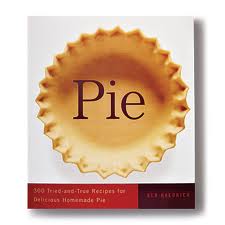I first wrote this book 6 years and 11 months ago. I said we were in peak pie season that August. This year? It has been so wet with a lingering winter that everyone is puzzled. Local strawberries are only now arriving at our farmers market. Each week is a guessing game. But, but, fruit is appearing and with it the chance to make fruit pies. This is a most American [and I guess British] experience. We brought a Blueberry and Cherry Pie this past weekend — recipe to come this weekend — to friends from Italy. They’d never experienced anything like it. These two books give you an exceptional range of pie opportunities. Give them a test run in your oven. And your tummy. You’ll be most happy.
We are two-thirds of the way through summer, and it is now peak season for pie makers. There are still berries to be had. Peaches abound. And soon, as fall enters, we’ll have apples by the ton. In just two months, fresh pumpkin pie will tempt us.
I like pies of all kinds, but fruit is dearer to me than even chocolate. I remember my first lemon meringue pie, from the Farmers Market at 3rd and Fairfax in Los Angles. Like a first kiss, that first pie was confirmation that life could be grand.
Suzen and I have collected pie books aplenty over the years. Pie books tend to be slim, with a few dozen recipes. Slimness is not bad and those smallish books have some wonderful ideas.
But when I am in a pie mood, when I need a pie encyclopedia for something different, where do I turn? I happen to be ambidextrous and therefore I can do two page turns at once. If you love pie, then there are two very thick books that you want to consult. Great Pies and Tarts by Carole Walter is a bible at almost 500 pages. Pie by Ken Haedrich comes to us with over 600 pages. Both books are wonderful and both are indispensable. And, they complement each other.
Do you want a tangerine pie, then you need Great Pies and Tarts. Is there a watermelon afoot in your kitchen, then you need Pie. And, Great Pies and Tarts does not address watermelon while tangerine does not appear in Pie. It turns out that these wonderful books truly complement each other.
If the slim books have a few dozen recipes, these two tomes have hundreds. Does size, or quantity, matter. It does.
When you ask someone to name a pie, they are going to answer “apple.” Then “cherry” and “berry” will pop up. “Peach” perhaps. “Watermelon?” Never.
Besides offering the most delicious spectrum of flavors, these two books serve a vital role. They capture and preserve a tradition of American pie recipes that might otherwise be lost. Pies from different eras and a different America. You won’t find a “Deep-Dish Pluot Pie with Oatmeal-Walnut Crumb Topping” in the freezer section of your supermarket. You will in Pie. “Creamy Green Grape Pie?” Not in the store but Carole has the recipe ready and waiting for you.
Over the coming weeks, you’ll see some great recipes here from these books — I’ve already posted Ken’s Watermelon Chiffon Pie. And, recipes for crust, lots of recipes. Pie crust is something that frightens too many of us to a shelf in our store we can find one “pre-made.” That’s really good marketing talk for manufactured. You want your own crust, your own personal crust, and we’ll have many good ideas here for you.
Along the way of this pie journey, you can visit Carole Walter at her website or join Ken Haedrich’s Pie Academy for lots of serious instruction. Just click here and enjoy:


